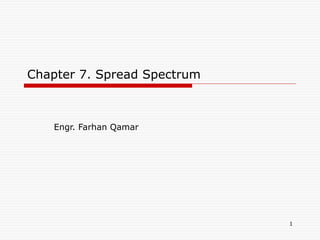
Spread Spectrum.ppt
- 1. 1 Chapter 7. Spread Spectrum Engr. Farhan Qamar
- 2. 2 Spread Spectrum Input is fed into a channel encoder Produces analog signal with narrow bandwidth Signal is further modulated using sequence of digits Spreading code or spreading sequence Generated by pseudonoise, or pseudo-random number generator Effect of modulation is to increase bandwidth of signal to be transmitted On receiving end, digit sequence is used to demodulate the spread spectrum signal Signal is fed into a channel decoder to recover data
- 3. 3 Spread Spectrum What can be gained from apparent waste of spectrum? Immunity from various kinds of noise and multipath distortion Can be used for hiding and encrypting signals Several users can independently use the same higher bandwidth with very little interference
- 4. 4 Frequency Hoping Spread Spectrum (FHSS) Signal is broadcast over seemingly random series of radio frequencies A number of channels allocated for the FH signal Width of each channel corresponds to bandwidth of input signal Signal hops from frequency to frequency at fixed intervals Transmitter operates in one channel at a time Bits are transmitted using some encoding scheme At each successive interval, a new carrier frequency is selected Channel sequence dictated by spreading code Receiver, hopping between frequencies in synchronization with transmitter, picks up message Advantages Eavesdroppers hear only unintelligible blips Attempts to jam signal on one frequency succeed only at knocking out a few bits
- 5. 5 Frequency Hoping Spread Spectrum
- 6. 6 FHSS Using MFSK MFSK signal is translated to a new frequency every Tc seconds by modulating the MFSK signal with the FHSS carrier signal For data rate of R: duration of a bit: T = 1/R seconds duration of signal element: Ts = LT seconds Tc Ts - slow-frequency-hop spread spectrum Tc < Ts - fast-frequency-hop spread spectrum
- 8. 8 FHSS Performance Considerations Large number of frequencies used Results in a system that is quite resistant to jamming Jammer must jam all frequencies With fixed power, this reduces the jamming power in any one frequency band
- 9. 9 Direct Sequence Spread Spectrum (DSSS) Each bit in original signal is represented by multiple bits in the transmitted signal Spreading code spreads signal across a wider frequency band Spread is in direct proportion to number of bits used One technique combines digital information stream with the spreading code bit stream using exclusive-OR (Figure 7.6)
- 10. 10 Direct Sequence Spread Spectrum (DSSS)
- 11. 11 DSSS Using BPSK Multiply BPSK signal, sd(t) = A d(t) cos(2 fct) by c(t) [takes values +1, -1] to get s(t) = A d(t)c(t) cos(2 fct) A = amplitude of signal fc = carrier frequency d(t) = discrete function [+1, -1] At receiver, incoming signal multiplied by c(t) Since, c(t) x c(t) = 1, incoming signal is recovered s(t) c(t) = A d(t) c(t) c(t) cos(2 fct) = sd(t)
- 13. 13 Code-Division Multiple Access (CDMA) Basic Principles of CDMA D = rate of data signal Break each bit into k chips Chips are a user-specific fixed pattern Chip data rate of new channel = kD
- 14. 14 CDMA Example If k=6 and code is a sequence of 1s and -1s For a ‘1’ bit, A sends code as chip pattern <c1, c2, c3, c4, c5, c6> For a ‘0’ bit, A sends complement of code <-c1, -c2, -c3, -c4, -c5, -c6> Receiver knows sender’s code and performs electronic decode function <d1, d2, d3, d4, d5, d6> = received chip pattern <c1, c2, c3, c4, c5, c6> = sender’s code 6 6 5 5 4 4 3 3 2 2 1 1 c d c d c d c d c d c d d Su
- 15. 15 CDMA Example User A code = <1, –1, –1, 1, –1, 1> To send a 1 bit = <1, –1, –1, 1, –1, 1> To send a 0 bit = <–1, 1, 1, –1, 1, –1> User B code = <1, 1, –1, – 1, 1, 1> To send a 1 bit = <1, 1, –1, –1, 1, 1> Receiver receiving with A’s code (A’s code) x (received chip pattern) User A ‘1’ bit: 6 -> 1 User A ‘0’ bit: -6 -> 0 User B ‘1’ bit: 0 -> unwanted signal ignored If A and B transmit signals SA and SB at the same time SA(SA+SB) = SA(SA) + SA(SB) = SA(SA) Orthogonal: The codes of A and B that have the property that SA(cB) = SB(cA) = 0
- 16. 16 CDMA Example
- 17. 17 CDMA for Direct Sequence Spread Spectrum
- 18. 18 Categories of Spreading Sequences Spreading Sequence Categories PN sequences Orthogonal codes For FHSS systems PN sequences most common For DSSS systems not employing CDMA PN sequences most common For DSSS CDMA systems PN sequences Orthogonal codes
- 19. 19 PN Sequences PN generator produces periodic sequence that appears to be random PN Sequences Generated by an algorithm using initial seed Sequence isn’t statistically random but will pass many test of randomness Sequences referred to as pseudorandom numbers or pseudonoise sequences Unless algorithm and seed are known, the sequence is impractical to predict
- 20. 20 Important PN Properties Randomness Uniform distribution Balance property Run property Independence Correlation property Unpredictability